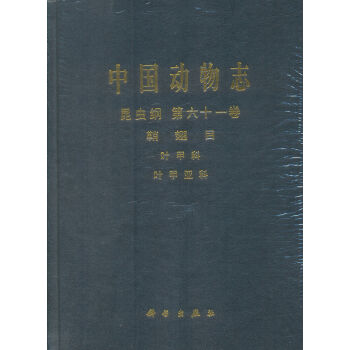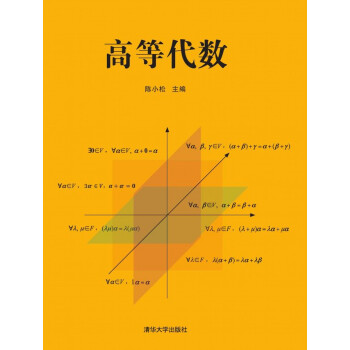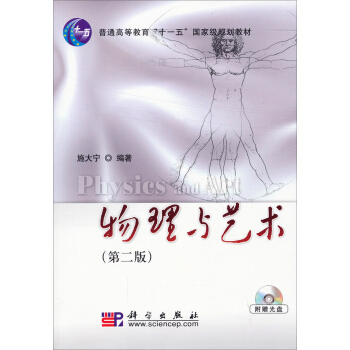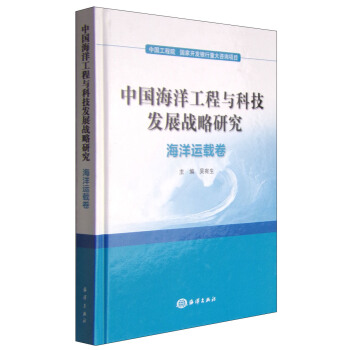![孤立子理论中的哈密顿方法 [Hamiltonian Methods in the Theory of Solitons]](https://pic.windowsfront.com/11321055/rBEhV1I4VD0IAAAAAAH9UIzdnCEAADTRgLUmecAAf1o067.jpg)

具体描述
内容简介
The book is based on the Hamiltonian interpretation of the method, hence the title. Methods of differential geometry and Hamiitonian formalism in particular are very popular in modern mathematical physics. It is precisely the general Hamiltonian formalism that presents the inverse scattering method in its most elegant form. Moreover, the Hamiltonian formalism provides a link between classical and quantum mechanics. So the book is not only an introduction to the classical soliton theory but also the groundwork for the quantum theory of solitons, to be discussed in another volume.The book is addressed to specialists in mathematical physics. This has determined the choice of material and the level of mathematical rigour. We hope that it will also be of interest to mathematicians of other specialities and to theoretical physicists as well. Still, being a mathematical treatise it does not contain applications of soliton theory to specific physical phenomena.
内页插图
目录
Introduction ReferencesPart One The Nonlinear Schrodinger Equation (NS Model)
Chapter Ⅰ Zero Curvature Representation
1.Formulation of the NS Model
2.Zero Curvature Condition
3.Properties of the Monodromy Matrix in the Quasi-Periodic Case
4.Local Integrals of the Motion
5.The Monodromy Matrix in the Rapidly Decreasing Case
6.Analytic Properties of Transition Coefficients
7.The Dynamics of Transition Coefficients
8.The Case of Finite Density.Jost Solutions
9.The Case of Finite Density.Transition Coefficients
10.The Case of Finite Density.Time Dynamics and Integrals of the Motion
1.Notes and References
References
Chapter Ⅱ The Riemann Problem
1.The Rapidly Decreasing Case.Formulation of the Riemann Problem
2.The Rapidly Decreasing Case.Analysis of the Riemann Problem
3.Application of the Inverse Scattering Problem to the NS Model
4.Relationship Between the Riemann Problem Method and the Gelfand-Levitan-Marchenko Integral Equations Formulation
5.The Rapidly Decreasing Case.Soliton Solutions
6.Solution of the Inverse Problem in the Case of Finite Density.The Riemann Problem Method
7.Solution of the Inverse Problem in the Case of Finite Density.The Gelfand-Levitan-Marchenko Formulation
8.Soliton Solutions in the Case of Finite Density
9.Notes and References References
Chapter Ⅲ The Hamiltonian Formulation
1.Fundamental Poisson Brackets and the /"-Matrix
2.Poisson Commutativity of the Motion Integrals in the Quasi-Periodic Case
3.Derivation of the Zero Curvature Representation from the Fundamental Poisson Brackets
4.Integrals of the Motion in the Rapidly Decreasing Case and in the Case of Finite Density
5.The A-Operator and a Hierarchy of Poisson Structures
6.Poisson Brackets of Transition Coefficients in the Rapidly Decreasing Case
7.Action-Angle Variables in the Rapidly Decreasing Case
8.Soliton Dynamics from the Hamiltonian Point of View
9.Complete Integrability in the Case of Finite Density
10.Notes and References
References
Part Two General Theory of Integrable Evolution Equations
Chapter Ⅰ Basic Examples and Their General Properties
1.Formulation of the Basic Continuous Models
2.Examples of Lattice Models
3.Zero Curvature Representation's a Method for Constructing Integrable Equations
4.Gauge Equivalence of the NS Model (#=-1) and the HM Model
5.Hamiltonian Formulation of the Chiral Field Equations and Related Models
6.The Riemann Problem as a Method for Constructing Solutions of Integrable Equations
7.A Scheme for Constructing the General Solution of the Zero Curvature Equation. Concluding Remarks on Integrable Equations
8.Notes and References
References
Chapter Ⅱ Fundamental Continuous Models
1.The Auxiliary Linear Problem for the HM Model
2.The Inverse Problem for the HM Model
3.Hamiltonian Formulation of the HM Model 4.The Auxiliary Linear Problem for the SG Model
5.The Inverse Problem for the SG Model
6.Hamiltonian Formulation of the SG Model
Chapter Ⅲ Fundamental Models on the Lattice
Chapter Ⅳ Lie-Algebraic Approach to the Classification and Analysis of Integrable Models Conclusion List of Symbols Index
……
Conclusion
List of Symbols
Index
前言/序言
用户评价
对于《孤立子理论中的哈密顿方法》这本书,我的第一反应便是它的严谨性。孤立子研究本身就不是易事,通常需要扎实的数学功底和对物理现象的深刻洞察。《哈密顿方法》的加入,更是将这种严谨性提升到了一个全新的高度。我预感这本书会是一本“硬核”读物,需要读者投入大量的精力去消化和理解。它可能不会像科普读物那样轻松有趣,但对于那些真正渴望深入理解孤立子理论底层数学机制的读者来说,它无疑是一座宝藏。我猜测书中会涉及大量复杂的数学推导和证明,并且对每一个概念的引入都会有详尽的解释和严密的逻辑链条。对于我而言,这样的书籍正是学习和研究的理想选择,因为它能够提供一个坚实的理论基础,帮助我构建起对孤立子行为更深层次的认知。或许,通过这本书,我能学会如何从哈密顿量的角度,以一种更加系统和统一的方式来分析和解决各种与孤立子相关的问题,而不再局限于特定的求解技巧。
评分这本《孤立子理论中的哈密顿方法》的书名,光是听着就有一种直击核心的专业感。孤立子,本身就是一个极具吸引力的概念,在非线性科学中占据着举足轻重的地位,而“哈密顿方法”更是物理学中一种深刻而强大的数学框架。我一直以来都对非线性现象以及描述它们的数学工具充满好奇,特别是像孤立子这样能够保持其形态和速度传播的特殊解,总让我觉得其中蕴含着某种深刻的物理原理。而将哈密顿力学与孤立子理论相结合,这本身就预示着一种高度抽象但又充满力量的分析视角。我设想,这本书会深入探讨如何运用哈密顿量来构建和理解孤立子的动力学行为,或许会涉及到泊松括号、正则变换、辛几何等一系列高级数学工具,并且这些工具将不仅仅是工具,更是理解孤立子本质的关键。我期待这本书能带领我穿越抽象的数学海洋,抵达孤立子世界最深邃的逻辑核心,去领略数学语言如何精准地刻画物理世界的奇妙。
评分听到《孤立子理论中的哈密顿方法》这个书名,我首先想到的是它在理论物理研究中的重要性。孤立子理论本身就涵盖了数学物理、非线性动力学、统计力学等多个领域,而哈密顿方法作为描述经典和量子系统的基本框架,与孤立子的结合,无疑会极大地拓展我们对这些复杂系统的理解。我推测,这本书会深入探讨哈密顿力学在构建和分析可积系统中的作用,并着重展示如何利用哈密顿形式主义来处理孤立子的相干性、相互作用以及能量守恒等关键问题。它或许会介绍一些进阶的数学工具,比如辛流形、李代数等,并说明这些工具如何帮助我们更深刻地理解孤立子的动力学性质。我期待这本书能够提供一种系统性的方法,帮助研究人员掌握如何利用哈密顿方法来设计和分析新的孤立子模型,以及如何将其应用于更广泛的物理问题,比如凝聚态物理、光学、甚至粒子物理等领域。
评分《孤立子理论中的哈密顿方法》,这个书名让我立刻联想到了一场思想的探险。我一直认为,科学的魅力在于它能够用简洁而优美的数学语言来描述复杂多变的自然现象,而孤立子和哈密顿方法恰恰是这种魅力的绝佳体现。这本书,我猜想,会是一次将抽象数学概念与具体物理模型巧妙结合的旅程。我期待它能阐释哈密顿量如何在孤立子系统中扮演核心角色,比如它如何编码了系统的守恒量,以及如何通过泊松括号的结构来揭示系统演化的规律。这本书可能会引导我一步步地构建出描述孤立子行为的哈密顿方程,并且展示如何利用这些方程来求解具体的孤立子模型,例如KdV方程、非线性薛定谔方程等等。更令我兴奋的是,我希望它能告诉我,哈密顿方法是如何提供一个统一的框架,使得不同类型的孤立子问题能够被以相似的数学语言来理解和分析,从而发现它们之间更深层次的联系。
评分《孤立子理论中的哈密顿方法》这个书名,在我看来,暗示着一种深度与广度的结合。孤立子作为一种独特的非线性波现象,其研究本身就具有跨学科的特性,而哈密顿方法作为一种普适的物理学理论框架,更是提供了理解和分析这些现象的强大工具。我设想,这本书会以一种极其系统的方式,从哈密顿力学的基本原理出发,逐步引入孤立子理论的核心概念,并展示如何利用哈密顿方法来解决孤立子方程的求解问题。我期待它能够详细阐述泊松括号如何刻画孤立子的动力学演化,以及如何通过对哈密顿量的分析来揭示系统的可积性。这本书也许会为读者提供一套完整的分析框架,让人们能够独立地去研究和发现新的孤立子模型,并且理解不同孤立子系统之间的内在联系。对于我来说,这样的书籍不仅能够提升我理论研究的水平,更能激发我对非线性科学更深层次的探索欲望,去发现隐藏在数学结构中的物理之美。
相关图书
本站所有内容均为互联网搜索引擎提供的公开搜索信息,本站不存储任何数据与内容,任何内容与数据均与本站无关,如有需要请联系相关搜索引擎包括但不限于百度,google,bing,sogou 等
© 2025 book.coffeedeals.club All Rights Reserved. 静流书站 版权所有




![实验室生物安全(第2版 供研究生及科研人员用)/全国高等医药教材建设研究会“十二五”规划教材 [Laboratory Biosafety] pdf epub mobi 电子书 下载](https://pic.windowsfront.com/11439608/rBEQYFNQ_j0IAAAAAAHAcklr6IgAAEsXAJzdNYAAcCK956.jpg)






![中国福建南部海洋鱼类图鉴(第二卷) [Marine Fishes of Southern Fujian,China] pdf epub mobi 电子书 下载](https://pic.windowsfront.com/11507352/53f2c175N79f8968d.jpg)






![当代科学地理译丛·学术专著系列:城市交通地理学 [The Geograohy of Urban Transportation] pdf epub mobi 电子书 下载](https://pic.windowsfront.com/11573813/546335b8Nd3aac0ab.jpg)

![数论中的美学 [The Aesthetics in Number Theory] pdf epub mobi 电子书 下载](https://pic.windowsfront.com/11633859/554025ddN49585504.jpg)